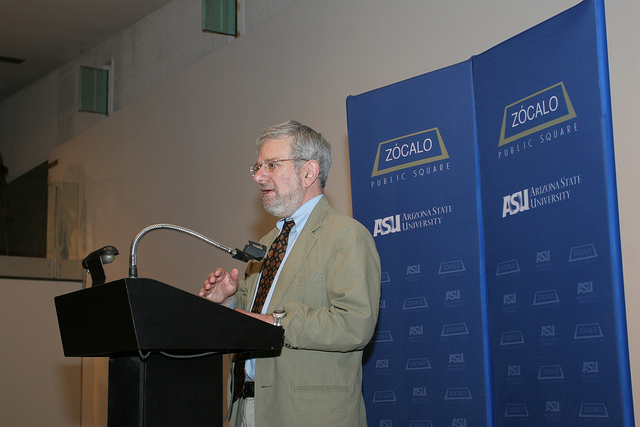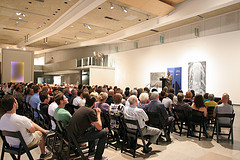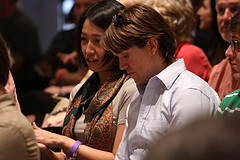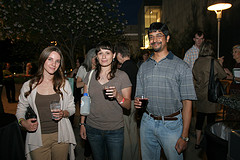
Americans are trading places. The more affluent are moving into city centers, and the lower classes are being displaced to the suburbs. It’s what urbanologist Alan Ehrenhalt calls a “demographic inversion.” This phenomenon, Ehrenhalt told a crowd at the Phoenix Art Museum, at an event co-presented by Arizona State University, means changing our concepts of cities, suburbs, and urban mobility.
Ehrenhalt believes that America’s cities will only become denser and more prosperous in the coming years. “This has major implications for the concept of space in American society,” he said. “We’re living in a moment in which the massive outward migration of the affluent that characterized the second half of the 20th century is coming to an end.”

There are a number of reasons for this extreme reversal. One is that cities are no longer manufacturing centers. New York, for example, “is not an industrial city” of tenements and factories. Random street violence in cities across the country has also declined, and as a result “people feel much more relaxed about being outside, about enjoying the city 24 hours a day.” In Washington, D.C., the most popular nightlife spot today, at 14th and U Streets, was the center of the 1968 riots; it took decades to rebound, and now young people crowd its sidewalks every night. The Millennials–the nation’s second-largest generation–also have different values than those of Generation X or the Baby Boomers: they don’t want to live in suburbs.
“So where are we in trying to create a 21st century sense of place?” Ehrenhalt asked. He likened 2012 to 1944, when Americans were trying to decide what they wanted their lives to look like after World War II. We’re nearing the end of an economic cataclysm, and there’s a debate going on about what comes after the great recession. “The world will be different, but how will it be different?”

Ehrenhalt believes that high-rise public housing and gated suburban communities will soon be things of the past. The future holds city centers, but not all of them will be downtown–there’s simply not enough space. Instead, “you’re going to have satellite urban centers” in suburbs. Old shopping malls are already being converted into city-like developments (Tyson’s Corner near Washington, D.C. is one example), and formerly suburban refuges are touting themselves as being more urban than people realize. “We’re going to have suburban town centers developing all over the place,” Ehrenhalt predicted, with higher density and walkable streets–even in sprawling Phoenix. “You’re going to see them mushroom in the Valley of the Sun.”
This revolution is being spearheaded by the young and the upwardly mobile. Empty nesters won’t flock to cities, but, as the older generation dies off, suburbs and exurbs will “find a niche … for the emerging middle class, for immigrants, for poor people.” McMansions might house more than one family, and, in the not-too-far future, “it will be cheaper to live 40 miles out than it will be to live in downtown Phoenix.”
According to Ehrenhalt, demographic inversion isn’t contingent on high gas prices or improved urban schools. He believes that the price of gas is only going to get higher, and some people will accept the costs of commuting while others won’t. And he thinks that rather than good schools luring families to cities, families move first, then demand good schools.

The Sunbelt hasn’t seen the same embrace of downtown living as the rest of the country–yet. Certainly, cities like Phoenix and Dallas have already done things that would have been unthinkable in the past, like building a light rail, making downtown pedestrian-friendly, and investing public money in these projects. Phoenix has had success with its well-utilized public transportation system and the growth of Arizona State University’s downtown campus. But it hasn’t achieved the large downtown residential population that it desires. “You might conclude that people in Phoenix just don’t want to live downtown,” said Ehrenhalt. “I don’t believe that’s true.”
Rather, downtown development in Phoenix and similar, sprawling cities needs to recalibrate. “It has to be a neighborhood, it has to be a community,” said Ehrenhalt. “It can’t just be developments and individual high-rise condos.” He believes that building smaller developments–specifically five-story residential buildings–is the solution. “Paris is composed mostly of five-story buildings, and that’s what makes it a beautiful city–the streets and buildings relate to each other in a harmonious way,” he said. People on the top floors and people on the street can see each other and even interact in a way. Smaller-scale buildings also create street life and make a city an exciting place to be.
In the question-and-answer session, audience members asked Ehrenhalt if he had more advice and inspiration for the region. Could mixed-use zoning help downtown Phoenix develop? Absolutely, he said, as could creating incentives for artists to move in.
Ehrenhalt also believes that Phoenix has yet to see the full effects of the light rail. It’s popular among students and among people looking for recreation and entertainment, but it hasn’t yet been embraced by commuters. Once developers build along the rail line–and they will, he predicted, because, unlike a changeable bus route, tracks are set–the commuters will come.
“Phoenix is not a global city at the moment,” said Ehrenhalt. “But it can be.”
Watch full video here.
See more photos here.
Buy the book: Skylight Books, Powell’s, Amazon.
Read expert opinions on how dense cities should be here.
Read an excerpt from The Great Inversion here.
*Photos by Felipe Ruiz-Acosta.




Send A Letter To the Editors